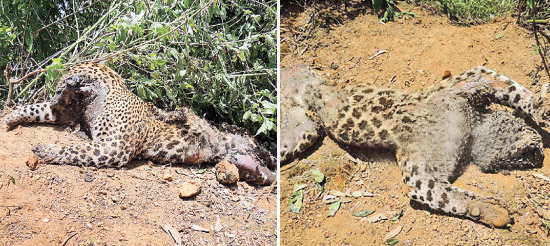|
Busting the myth of a :
Human - Leopard conflict
By Kishani Samaraweera
The Sri Lankan leopard, scientifically known as Panthera pardus kotiya has been
listed as an endangered animal by the International Union for Conservation of
Nature ( IUCN) Red List of Threatened Species. While leopards are found across a
large swathe of the island, they are mostly concentrated in the north west and
the south east, areas corresponding to the Yala and Wilpattu National Parks.
However, outside these protected areas, a significant leopard population is also
found in the hill country. As forest areas in Sri Lanka’s hills have come under
intense pressure with increased deforestation and encroachment, leopards and
humans in the hills have been drawn into a one-sided conflict, with leopards
being the clear loser.
Not conflict, but massacre
Over the past few weeks a spate of leopard killings have been reported in the
hills. Senior environmental lawyer, Jagath Gunawardena is of the view that it is
not actually a conflict between human beings and leopards, but that people
deliberately kill leopards for the flesh and the skin.
Currently, less than 18% of the Hill Country is covered by natural forests, with
villages, estates and small farms accounting for most of the area. Hence, as
leopards wander into human areas they become easy targets.
 |
| Jagath
Gunawardena |
 |
| Nimalka
Sanjeewani |
 |
| Pubudu
Weeraratne |
“There is encroachment in the forests; there is illegal deforestation and forest
fires. As a result, the animals are running out of space and food,” said
Gunawardena.
Numbers
According to Gunawardena, even the reports stating that large numbers of
leopards are being killed, are unreliable, and represent only a fraction of the
total number of leopards actually killed.
“My suspicion is for every two killings reported, there may be one killing which
goes unreported. Although harming or killing a leopard is a non bailable offence
which carries a high penalty, people have not stopped committing such acts.”
Deforestation
Central Environmental Authority Board member, Ajitha De Costa explained that
deforestation is not only a threat to the leopards, but also makes the land
vulnerable to landslides and creates a shortage of water as well. “From Horton
Plains to Haputale, the entire area is deforested. There is a high probability
of the area facing landslides,” he said.
Pointing out that forest patches between estates have been cut by the villagers
for firewood, thereby depriving the leopards of their habitat, De Costa says it
is the fault of the people that has led to a series of issues.
He said, yet another reason for the decrease of leopards in the area covered by
forests is forest fires. Forest fires often result due to attempts by residents
to clear jungle areas for cultivation.
Awareness
 |
|
The one which underwent
dental extraction and the other, sans claws! |
Outreach Officer of the Leopard Project, Nimalka Sanjeewani said, they are
currently conducting public awareness programs via lectures, television programs
and informal community based talks.
“The behaviour of the animal is such that they wander in search of food. With
deforestation, they tend to come to villages. Leopards are active mostly at
night, so we have advised people to keep their pets and other animals in cages
since such animals can be easy prey for leopards,” she said.
According to Sanjeewani, the Leopard Project conducted by The Wilderness &
Wildlife Conservation Trust intends to make the public aware through community
awareness programs in border settlements and tea estate communities, and thereby
attempt to reduce the numbers affected by the human-animal conflict.
Media’s responsibility
Head of the Biodiversity Conservation Centre, Pubudu Weeraratne criticized the
media for creating the notion of a human-leopard conflict and fuelling fears of
villagers.
“Media has not done what is expected of them. All they did was create more
issues by scaring the public. The issue has been clearly blown out of
proportions,” he said.
The long term survival of the hill country leopard populations is a complex and
difficult task. Jagath Gunawardena however, believes, to mitigate the situation
a holistic plan is needed. He says, the issue of leopard killings is yet a facet
of the degradation and destruction of their habitat.
“Trying to find a solution only for the leopard issue will blind us to the
bigger picture. If that is addressed then the other matters are invariably
solved, he said. |

